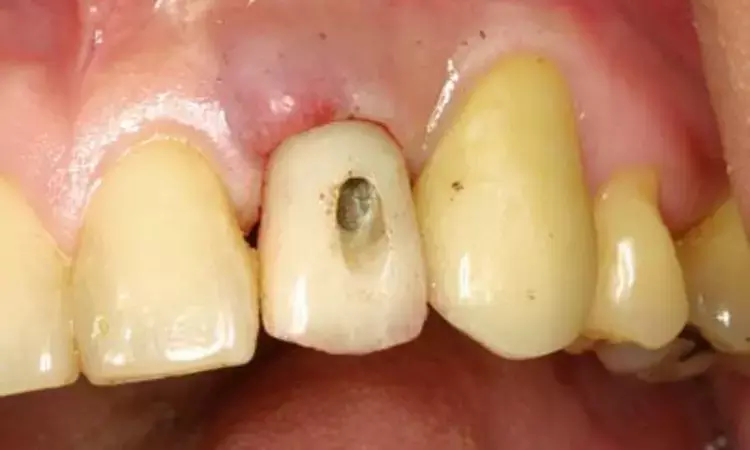- Home
- Medical news & Guidelines
- Anesthesiology
- Cardiology and CTVS
- Critical Care
- Dentistry
- Dermatology
- Diabetes and Endocrinology
- ENT
- Gastroenterology
- Medicine
- Nephrology
- Neurology
- Obstretics-Gynaecology
- Oncology
- Ophthalmology
- Orthopaedics
- Pediatrics-Neonatology
- Psychiatry
- Pulmonology
- Radiology
- Surgery
- Urology
- Laboratory Medicine
- Diet
- Nursing
- Paramedical
- Physiotherapy
- Health news
- Fact Check
- Bone Health Fact Check
- Brain Health Fact Check
- Cancer Related Fact Check
- Child Care Fact Check
- Dental and oral health fact check
- Diabetes and metabolic health fact check
- Diet and Nutrition Fact Check
- Eye and ENT Care Fact Check
- Fitness fact check
- Gut health fact check
- Heart health fact check
- Kidney health fact check
- Medical education fact check
- Men's health fact check
- Respiratory fact check
- Skin and hair care fact check
- Vaccine and Immunization fact check
- Women's health fact check
- AYUSH
- State News
- Andaman and Nicobar Islands
- Andhra Pradesh
- Arunachal Pradesh
- Assam
- Bihar
- Chandigarh
- Chattisgarh
- Dadra and Nagar Haveli
- Daman and Diu
- Delhi
- Goa
- Gujarat
- Haryana
- Himachal Pradesh
- Jammu & Kashmir
- Jharkhand
- Karnataka
- Kerala
- Ladakh
- Lakshadweep
- Madhya Pradesh
- Maharashtra
- Manipur
- Meghalaya
- Mizoram
- Nagaland
- Odisha
- Puducherry
- Punjab
- Rajasthan
- Sikkim
- Tamil Nadu
- Telangana
- Tripura
- Uttar Pradesh
- Uttrakhand
- West Bengal
- Medical Education
- Industry
Screw-retained dental restorations fail to prevent peri-implantitis versus cement-retained implant-supported prostheses

Screw-retained dental restorations fail to prevent peri-implantitis compared to cement-retained implant-supported prostheses suggests a new study published in the Journal of Pediatric Dentistry.
Implant-supported fixed dental prostheses can be cement- or screw-retained on the implant or abutment, with advantages and disadvantages for each method. Cemented prostheses have been associated with peri-implant disease because cement remnants act as a reservoir for bacteria and hinder biofilm control. However, contrasting evidence has been presented regarding this association based on studies with varying designs, and a systematic review and meta-analysis is required.
The purpose of this systematic review and meta-analysis was to answer the focused question: In patients who received implant-supported prostheses, is the incidence of peri-implant diseases higher in cemented implant-supported prostheses than in screw-retained ones?
The search was conducted using the National Library of Medicine (MEDLINE-PubMed), SCOPUS, EMBASE, and ISI Web of Science databases. Randomized clinical trials (RCTs) that assessed the incidence of peri-implant disease in cement- and screw-retained prostheses were included. Two authors independently screened the titles and abstracts, and analyzed the full texts, extracted data, and assessed the risk of bias. The findings were summarized using meta-analyses with random effects, and the level of certainty of the evidence was determined using the grading of recommendations, assessments, development, and evaluations (GRADE) approach.
Results
The search yielded 4455 articles that met the inclusion criteria based on the title and/or abstract selection. A total of 6 RCTs were included for analysis. The meta-analysis revealed no significant difference between cement- and screw-retained prostheses for the risk of peri-implant mucositis (RR: 1.36, 95% CI: 0.42–4.38, P=.61). Similarly, no significant difference was observed between cement- and screw-retained prostheses for the incidence of peri-implantitis (RR: 1.00, 95% CI: 0.23–4.31, P=1.00).
Moderate certainty evidence suggests that cement- and screw-retained prostheses present a similar risk for peri-implant mucositis and peri-implantitis.
Reference:
Incidence of peri-implant disease associated with cement- and screw-retained implant-supported prostheses: A systematic review and meta-analysis
Isabella Neme Ribeiro dos Reis,Gisele Lie Fukuoka, Bruna Egumi Nagay, Claudio Mendes Pannuti, Rubens Spin-Neto, Emily Vivianne Freitas da Silva. Published:October 02, 2023DOI:https://doi.org/10.1016/j.prosdent.2023.08.030
Keywords:
Screw-retained, dental, restorations, fail, prevent, peri-implantitis, compared, cement-retained, implant-supported, prostheses, Journal of Pediatric Dentistry, Isabella Neme Ribeiro dos Reis,Gisele Lie Fukuoka, Bruna Egumi Nagay, Claudio Mendes Pannuti, Rubens Spin-Neto, Emily Vivianne Freitas da Sil
Dr. Shravani Dali has completed her BDS from Pravara institute of medical sciences, loni. Following which she extensively worked in the healthcare sector for 2+ years. She has been actively involved in writing blogs in field of health and wellness. Currently she is pursuing her Masters of public health-health administration from Tata institute of social sciences. She can be contacted at editorial@medicaldialogues.in.
Dr Kamal Kant Kohli-MBBS, DTCD- a chest specialist with more than 30 years of practice and a flair for writing clinical articles, Dr Kamal Kant Kohli joined Medical Dialogues as a Chief Editor of Medical News. Besides writing articles, as an editor, he proofreads and verifies all the medical content published on Medical Dialogues including those coming from journals, studies,medical conferences,guidelines etc. Email: drkohli@medicaldialogues.in. Contact no. 011-43720751


